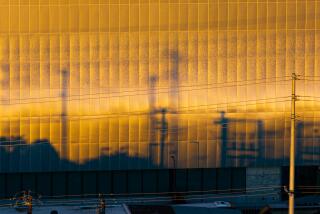U.S. Will Fund Nuclear Fusion Research at Russian Lab : Science: The project will cost Energy Dept. just $90,000 for a year. American experts will have access to the instituteâs work.
WASHINGTON â In an unprecedented use of U.S. money to sustain cutting-edge Russian research, the United States has decided to fund a major Russian nuclear laboratory, paying the salaries of 116 former Soviet scientists to work on harnessing nuclear fusion for civilian use, officials said Thursday.
The Department of Energy plans to support the fusion research program of Moscowâs Kurchatov Institute at a price that is a bargain by Western standards: roughly $65 a month for each scientist--a total of only $90,000 in a one-year contract.
In exchange, U.S. scientists will enjoy continued access to the instituteâs work, which includes the worldâs highest power âgyrotronâ--a device that uses microwaves to heat nuclear fuel to temperatures of millions of degrees Celsius.
The ultimate aim of the research is to tame fusion--the thermonuclear reaction that produces the vast energy of the sun--for everyday human use. The United States and Russia have been cooperating on fusion research since 1974, when Russia was part of the Soviet Union.
âWeâre very pleased,â said N. Anne Davies, chief of the Energy Departmentâs fusion office. âThey are awfully good people at the Kurchatov Institute and they are doing work thatâs very relevant to what we are doing here.
âThis is an extension of work weâve already been doingâ with the Russians, she added. âWhatâs unusual about this arrangement is that now we are funding their work.â
The joint project, which will also include exchanges of U.S. and Russian scientists, will be managed by General Atomics Corp., located near the UC San Diego campus in the northern part of the city.
âWe also plan an exchange of small hardware--weâll bring hardware there, and theyâll bring hardware here,â Davies said.
That could be crucial to keeping the Russian research program going, she said, âbecause they no longer have the foreign exchange to buy equipment from abroad.â
The results of the research, she said, will be made freely available in both Russia and the United States.
The project was reviewed and approved by officials at the Defense Department and other agencies to ensure that it would not result in any increase in Russiaâs military expertise at U.S. expense, she said.
Fusion is the nuclear reaction that produces the massive destructive power of the hydrogen bomb--when the reaction is triggered but not controlled. Fusion generates power by fusing simple, common elements, like hydrogen. (Fission, the process used at nuclear power plants now, generates energy by splitting complex, expensive elements, like uranium.)
For more than 30 years, scientists have sought to create fusion in a controlled way, because it could produce virtually unlimited energy at modest cost.
Work has been done at both the Kurchatov Institute and General Atomics centers on experimental fusion reactors called âtokamaks,â a Russian acronym for a doughnut-shaped magnetic chamber that confines nuclear fuel. The Russian researchers have moved ahead of their counterparts elsewhere at using high-frequency microwaves to heat the fuel, which presses the atoms together to produce fusion.
Davies said that the Energy Department hopes the fusion work can produce a prototype power plant by the year 2025 and a commercially usable plant by 2040. âIt doesnât have near-term commercial applications,â she said.
The Energy Department will employ the Russian scientists independently of the Bush Administrationâs plan to use part of $400 million transferred from the defense budget to put to work scientists from the former Soviet Union who otherwise might seek jobs in Iraq, Libya or other countries working on nuclear weapons.
It grew out of a visit to the Kurchatov Institute last November by Davies and other U.S. officials, who were startled to hear the laboratoryâs directors estimate that they could keep running for a full year with a grant of less than $100,000.
âItâs a very good buy,â Davies said.
The estimated salary of $65 a month for the instituteâs researchers is extraordinarily low by Western standards.
But even $65 a month may turn out to be a raise for many scientists. Some senior physicists at the Kurchatov Institute were reported recently to be receiving salaries of 3,500 rubles per month--about $35 at the current exchange rate.
More to Read
Sign up for Essential California
The most important California stories and recommendations in your inbox every morning.
You may occasionally receive promotional content from the Los Angeles Times.











